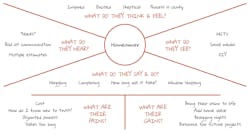As a white-glove service, high-touch design-build remodeler, scaling up the business can be tricky. When deciding to grow Cornerstone Remodeling, we found our sales process held us back. Today, it’s four times faster, and we sell at a pace comparable to a company five times our size.
We initially spent a lot of time dialing in project details and presenting an amazing estimate to our homeowners, which resulted in higher closing rates. This capped how much work we could take on. If we were to grow, we’d have to hire. It’s a common challenge.
In adjacent industries, like home improvement, the sales cycle is short, making it easier to get high revenue and fast turnover. We are not a quick-turn business, but I set out to make our cycle shorter while keeping the customer perspective in mind. In just under two years, revenue has more than doubled.
First, we poked holes in our process and took a stab at every bottleneck, and in our discovery, we began to re-engineer the whole process. It all began with empathy mapping.
1. Empathy Mapping
We wanted to know the adjustable and the untouchable steps in our sales process, so we empathy mapped.
Empathy mapping helps you understand the customer perspective by writing down what homeowners think, feel, hear, and say when it comes to remodeling their home.
It’s an exercise for understanding what drives decision-making, and it acted as our starting point for streamlining.
We looked at everything across the spectrum, from our social media, branding, content, reviews, customer pains and gains, to what they feel throughout the remodeling process. We wrote it all down: homeowners get overwhelmed; the process is clunky; they don’t know what to expect.
It took me, my general manager, and a designer three hours. I’d suggest including your sales team and higher-level players on the production side.
After the exercise, we had a list of tasks in our sales process we could adjust or keep, and made decisions based on whether they would relieve homeowner pains or support their gains.
2. Moscow Prioritization
A major bottleneck in our sales process was initial concepts. This got too into the weeds early on, becoming overly time-consuming. MoSCoW is a prioritization tool that stands for must-have, should-have, could-have, and will not have.
We needed a better way to prioritize a homeowner’s project scope and ultimately, for them to self-prioritize.
We made MoSCoW a fun exercise for clients and now send them a Google Form before the first home visit. This was important because we wanted to help them understand what lay ahead. In empathy mapping, we identified remodeling as a clunky process that overwhelms clients. They don’t know where to start. They need structure and want to know next steps.
For the “will not have” section, we tell customers that items will move into this area as we go through the budget conversation.
MoSCoW shows us what’s really important to the homeowner. We then say to them, “If we accomplish this entire list, you’re projected somewhere in the ballpark of $250,000 to $500,000. Is that what you want to spend?”
Typically, the answer is “no.” Then we say, “Would you be okay if we explored all of your must-haves and perhaps some should-haves, which looks like a range of $150,000 to $200,000?”
Once that proposal is sent their way, the conversation typically turns to exploring one or two should-haves and adding it to the proposal, rather than taking time to explore 12 should-haves up front.
MoSCoW helped us spend much less time until we knew where they were budget-wise. By the time they proceed, we know it’ll be with us.
Before using the MoSCoW, we sent specific questions and checklists with the designer and project developer to the home, but it was vague. Homeowners always want to do everything and there was no focused effort on dialing in on that first pass concept and estimate.
3. A Journey Book
Empathy mapping pulled up apprehension. Customers didn’t know where to begin with budgets and didn’t want to feel taken advantage of. Customers also love inspiration. We took those ideas and brainstormed a tool that proves our estimates aren’t numbers pulled out of thin air.
They needed real-life examples, and we have hundreds of them. We identified five levels of each type of typical project, selected 10 for each, and included 50 projects in what we call the Journey Book.
Our designer pulled original plans and photos from these jobs. Each project has the homeowner journey, initial concepts, the comfort zone budget, and the final price.
We send the Journey Book to clients with design agreements. It also highlights the design-build process, what a comfort zone budget is, and the Cornerstone creative process.
Homeowners want to be impressed. We achieve this through the Journey Book, combined with what we call our power stack—our tech stack that allows us to pack a punch on deliverables. This includes faster measurements with RENDR and CAD modeling with Chief Architect to building visually beautiful proposals with simple Canva templates.
Perfecting the sales process will take several iterations, and mine will not be applicable for every design-build, but give yourself the freedom to pivot. Our goal was to develop a sales process that worked for us and the homeowner, ensuring the clients’ perspective was kept front and center while helping us scale.
About the Author

AJ Ballantine
AJ Ballantine is the co-owner of Cornerstone Remodeling in Ellicott City, Md. and RENDR, a virtual measuring tool for contractors.

